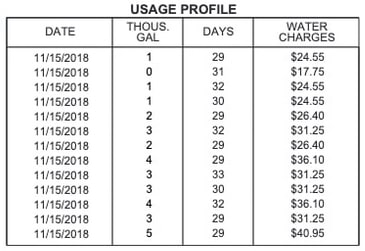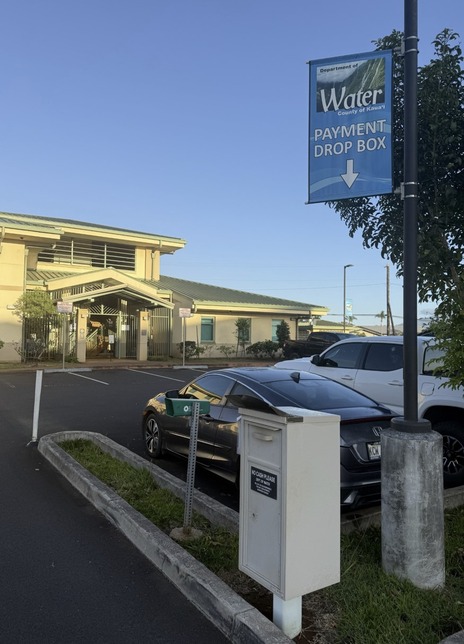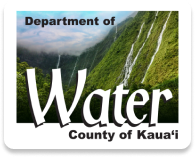Frequently Asked Questions
Applications, Transfers or Stopping Service
The deposit serves as a security deposit to guarantee a last bill payment when a tenant moves out or transfers accounts.
One business day notice is required to start a service if all documents are received prior to 3pm. Friday requests are not accommodated until the following Monday, Tuesday if Monday is a holiday; granted all documents are complete.
You should cancel services so that we are able to properly transfer the bill and account contact information to the new customer; and stop billing you for their water usage. Until service is cancelled, you will be responsible for water usage.
For General Name Changes
You must open a new account. If you are the owner of the property, complete and submit the Application for Water Service form and include a photo ID and proof of ownership. If you’re a tenant, provide the same info above along with a rental/lease agreement and a $210 deposit by cash or check.
For Name Changes Because of a Death
You must open a new account. We require ownership documents or a rental agreement and a $210 tenant deposit, for non-owners applying for service. Complete and submit the Application for Water Service form and include a photo ID and death certificate.
Billing and Collections
Yes. As long as they have your account number, copy of your bill or physical address to identify the correct billing account.
To set up, complete and submit an Automatic Bill Payment (ABP) form, along with a voided blank check to our office either in person, by email, or via postal mail.
To stop an auto payment, you will need to contact our office at (808) 245-5442 or billing@kauaiwater.org to stop or cancel ABP services.
No, meter readers do not accept bill payments. You may pay via mail, online through our Customer Account Portal, or establish automatic bill payment (ABP) service.
The Department of Water utilizes a payment service provider, which is located on Oʻahu.
We bill by 1,000 gallons, so your usage could be in the same range every month.
The monthly service charge is a fixed charge to recover the cost of service to operate and maintain the infrastructure put in place to deliver the water supply.
Please call us at (808) 245-5442 or email billing@kauaiwater.org so we can confirm that your mailing address and contact information is correct.
Customers may find this information online in the customer account portal or on their January statement. It will list 13 months of prior consumption and charges under the ‘Usage Profile’ located in the top left-hand corner of the bill.


There is a 24-hour payment drop box located in the parking lot. CHECK OR MONEY ORDER PAYMENTS ONLY. Do not submit cash. You may also pay your bill via our online Customer Account Portal.
General
Sometimes if water in your house is not used, the microbes in the pipes can grow and cause odors and funny taste. Flushing the water can resolve this problem. Water should be flushed in the morning or when not used for an extended period of time.
Air trapped in the water lines causes this problem. Let the water sit in a glass and if the water becomes clear from the bottom up, air is the cause and the water is safe to drink. This is normal and if it occurs, you may flush water out from an outside hose spigot until water is clear.
Please call operations at (808) 245-5444.
This may be caused by a leak on your property or you may have a pressure reducing valve installed on your house that has failed. Another cause may be a leak on the County’s water line, or a fault with the County’s pressure reducing valve, these problems would cause your neighbors to experience pressure loss also. Please call operations at (808) 245-5444 with any questions.
Service Outages
Hours of Operation
Monday – Friday: 7:45 am – 4:30 pm
To report the service issue during business hours: (808) 245-5444.
After-hours, call Police dispatch: (808) 241-1711. They will contact our standby crew for further investigation.
While DOW crews make every effort to restore water service as quickly and as safely as possible, it is difficult to estimate when service will be restored due to unforeseen issues and necessary water system adjustments.
After a service outage, water may appear cloudy due to tiny air bubbles that are released after being trapped in the water pipes, much like air bubbles seen in a bottle of soda when you first open it. This water is perfectly safe to drink. If you allow the water to sit for a few moments, the cloudiness will slowly dissipate.
After a service outage, water may appear brown due to the disturbance of pipeline sediments in the water main, that may have occurred during the pipeline repair work. Running the faucet or outside hose bib for five minutes will flush the lines, and usually addresses the issue. If the issue persists, call DOW to report it.
This may be caused by a leak on your property or you may have a pressure reducing valve installed on your house that has failed. Another cause may be a leak on the County’s water line, or a fault with the County’s pressure reducing valve, these problems would cause your neighbors to experience pressure loss also. Please call operations at (808) 245-5444 with any questions.
Water Quality
Sometimes if water in your house is not used, the microbes in the pipes can grow and cause odors and funny taste. Flushing the water can resolve this problem. Water should be flushed in the morning or when not used for an extended period of time.
Air trapped in the water lines causes this problem. Let the water sit in a glass and if the water becomes clear from the bottom up, air is the cause and the water is safe to drink. This is normal and if it occurs, you may flush water out from an outside hose spigot until water is clear.
Chlorine is added to control microbe levels in the water distribution system to keep the water safe. The chlorine level ranges between 0.1 to 0.5 ppm and these small amounts of chlorine do not pose a health hazard. If you want to remove chlorine, either let it sit for a while or filter it through an activated carbon filter.
All sources of drinking water, including both tap water and bottled water, include rivers, lakes, streams, ponds, reservoirs, springs and wells. As water travels over the surface of the land or through the ground, it dissolves naturally occurring minerals and, in some cases, radioactive material, and can pick up substances resulting from the presence of animals or from human activity.Therefore, drinking water, including bottled water may reasonably be expected to contain at least small amounts of some contaminants. The presence of contaminants does not necessarily indicate that the water poses a health risk.
Some people may be more vulnerable to contaminants in drinking water than the general population. Immune-compromised persons such as persons with cancer undergoing chemotherapy, persons who have undergone organ transplants, people with HIV/AIDS or other immune system disorders, some elderly and infants can be particularly at risk from infections. These people should seek advice about drinking water from their healthcare providers.
Guidelines on appropriate means to lessen the risk of infection by Cryptosporidium and other microbial contaminants are available from the EPA’s safe drinking water hotline at 1-800-426-4791 or by email: safewater@epa.gov.
